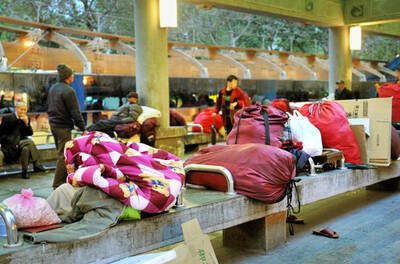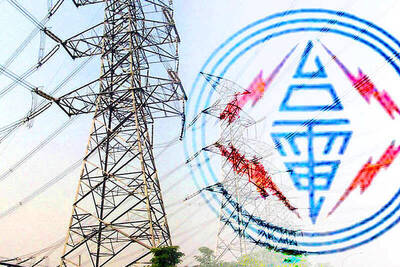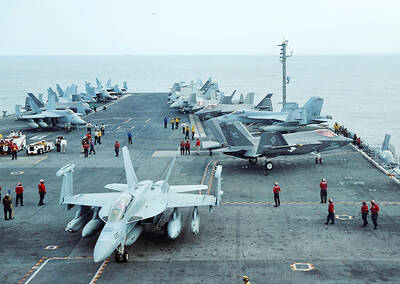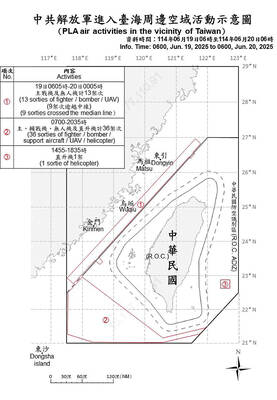The International Civil Aviation Organization (ICAO) expanded the Taipei Flight Information Region one degree east in 1955 to improve air traffic control operations, but the move also created problems for Taiwan’s aviation authorities, a Civil Aeronautics Administration (CAA) official said.
Feng Ying-pin (馮英彬) said on Monday that when the ICAO demarcated Taiwan’s flight information region in 1953, the eastern border was set at 123o east.
Since airplanes at the time were slower, Taiwanese planes flying to Japan were usually unable to reach a level altitude before they left the region, forcing them to hand air control operations over to Japanese authorities.
Feng said that in consideration of the difficulty this gave air traffic control operators, the ICAO moved the eastern part of the flight information region one degree to 124o east in 1955 — which put it inside Japan’s air defense identification zone.
A country’s flight information region and its air defense identification zone are usually identical, he said, but the ICAO’s changes created an unusual situation for Taiwan and Japan.
The overlap has caused trouble for the CAA, he said, as the Japan Self-Defense Forces heighten their alert whenever a Taiwanese aircraft passes through the overlapping areas.
In 2002, for example, Japanese defense aircraft interfered with the radio transmissions of a Taiwanese plane testing a new air route through the area.
The CAA used diplomatic channels to ask Japan not to interfere with civil aircraft that had made applications to pass through the overlapping zone.
The opening of direct flights between Taiwan and China several years later made matters more complicated, as the flight path designated B591 travels through the area.
Taiwan has complied with Japanese instructions to give flight plans for all civilian aircraft flying through the zone since 2009.

A year-long renovation of Taipei’s Bangka Park (艋舺公園) began yesterday, as city workers fenced off the site and cleared out belongings left by homeless residents who had been living there. Despite protests from displaced residents, a city official defended the government’s relocation efforts, saying transitional housing has been offered. The renovation of the park in Taipei’s Wanhua District (萬華), near Longshan Temple (龍山寺), began at 9am yesterday, as about 20 homeless people packed their belongings and left after being asked to move by city personnel. Among them was a 90-year-old woman surnamed Wang (王), who last week said that she had no plans

TO BE APPEALED: The environment ministry said coal reduction goals had to be reached within two months, which was against the principle of legitimate expectation The Taipei High Administrative Court on Thursday ruled in favor of the Taichung Environmental Protection Bureau in its administrative litigation against the Ministry of Environment for the rescission of a NT$18 million fine (US$609,570) imposed by the bureau on the Taichung Power Plant in 2019 for alleged excess coal power generation. The bureau in November 2019 revised what it said was a “slip of the pen” in the text of the operating permit granted to the plant — which is run by Taiwan Power Co (Taipower) — in October 2017. The permit originally read: “reduce coal use by 40 percent from Jan.

China might accelerate its strategic actions toward Taiwan, the South China Sea and across the first island chain, after the US officially entered a military conflict with Iran, as Beijing would perceive Washington as incapable of fighting a two-front war, a military expert said yesterday. The US’ ongoing conflict with Iran is not merely an act of retaliation or a “delaying tactic,” but a strategic military campaign aimed at dismantling Tehran’s nuclear capabilities and reshaping the regional order in the Middle East, said National Defense University distinguished adjunct lecturer Holmes Liao (廖宏祥), former McDonnell Douglas Aerospace representative in Taiwan. If

‘SPEY’ REACTION: Beijing said its Eastern Theater Command ‘organized troops to monitor and guard the entire process’ of a Taiwan Strait transit China sent 74 warplanes toward Taiwan between late Thursday and early yesterday, 61 of which crossed the median line in the Taiwan Strait. It was not clear why so many planes were scrambled, said the Ministry of National Defense, which tabulated the flights. The aircraft were sent in two separate tranches, the ministry said. The Ministry of Foreign Affairs on Thursday “confirmed and welcomed” a transit by the British Royal Navy’s HMS Spey, a River-class offshore patrol vessel, through the Taiwan Strait a day earlier. The ship’s transit “once again [reaffirmed the Strait’s] status as international waters,” the foreign ministry said. “Such transits by